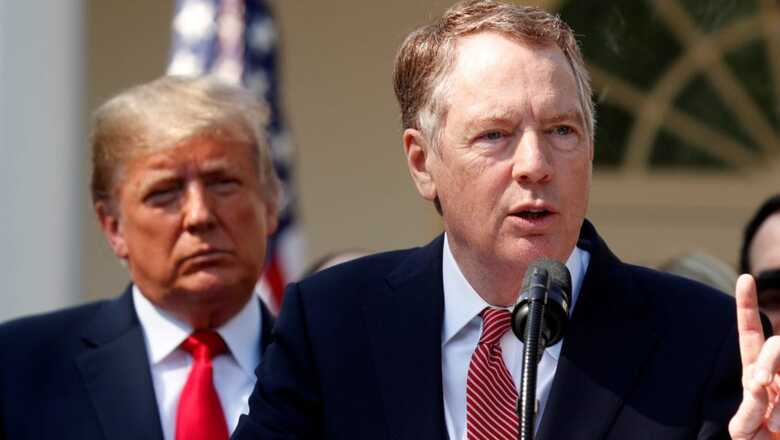
views
Robert Lighthizer, who served as President Donald Trump’s trade representative between 2017 and 2021 in his book titled No Trade is Free: Changing Course, Taking on China and Helping America’s Workers published last year, claimed that he told Prime Minister Narendra Modi during a meeting that India is the ‘world’s most protectionist country’ and that its trade practices were hurting American farmers and leading to a large trade deficit while contributing to job losses in America.
News18 has not independently verified the details of the conversations that Lighthizer has claimed to have with Indian officials.
He also wrote in his book that he kept the biographies of 15 Indian billionaires on his desk as he prepared for trade negotiations with Indian counterparts during his time at the Trump administration.
He claims in his book that “oligarchs” influence government policy despite India having an “extremely strong professional bureaucracy” in all areas of the government.
“When I was in negotiations with Indian officials, I kept a copy of the biography of each of the country’s 15 or so billionaires on my desk. In predicting Indian government positions, I would look to the interests of these men. I can remember at one point telling an Indian friend of mine who had made a fortune in business that I thought there were 15 oligarchs who basically ran the country. He corrected me. ‘Bob you’re wrong. Only about seven of them actually run the country. The others just try to influence the seven’,” Lighthizer noted in his book.
Robert Lighthizer, according to a report by Hindustan Times, was considered as a barrier to constructive trade talks and a spoiler within the then-Trump administration on the India-US relationship.
It is likely that Trump will approach Robert Lighthizer once more if he is reelected and the report by Hindustan Times also said that he is likely to get a cabinet-rank position handling trade again.
In his book, Lighthizer recognised India’s strengths and lauded Prime Minister Narendra Modi for taking steps to lift India out of poverty. “Prime Minister Narendra Modi is a particularly interesting figure. He came up through the ranks of right-wing political organisations and clearly considers himself a nationalist…He is an extremely gifted politician and the first leader of India who was born after its independence in 1947,” he writes.
“Modi is dedicated to raising India out of poverty. He believes in doing it through state control of innovation, high tariffs, mercantilism, and protectionism. There are lots of hangovers from the time of British rule, but free trade is not one of them,” he further added.
Trade Tussle with India, US-China Relations
Robert Lighthizer writes that the Trump administration’s strategy with India was to “maintain good relations” but then use its leverage to “increase our access to their market, to obtain fairness and reciprocity in trade, and to achieve balance”.
Setting this as the background, Lighthizer shares his side of the story on why the Generalised System of Preferences (GSP) system became a key fault line between India and the US.
Lighthizer has acknowledged that the US “tried to leverage” India’s use of GSP, “a duty-free programme”, to obtain more access. “India is by far the biggest user of the program. A large percent of all its imports come into the United States under this preference duty-free. While India uses GSP and runs large trade surpluses with us, it denies us equal access to its market and charges our producers high tariffs,” he writes.
The US took away India’s GSP status in June 2019. Lighthizer claims they tried to restore it in exchange for better access to India’s market. However, the Trump administration realised it wouldn’t happen because India doesn’t usually open its market, and the demands were being made during the farmers’ protest.
Indian officials, according to the newspaper, said that they showed flexibility when possible and retaliated when needed, even using counter-tariffs, in order to defend Indian economic interests. The officials also found that it was challenging to deal with an administration that was erratic and also shifted its priorities but they focussed on resisting Trump’s pressure, seeing it as a sign of strength and commitment to national interests.
In discussing India’s industrial policy, Lighthizer mentioned the Make in India and Atmanirbhar Bharat initiatives and said India aims to attract more foreign investment, reduce regulations, boost exports, and protect certain sectors like electronics and communication devices.
However, Lighthizer also claims that India subsidises exports through tax breaks and exemptions, especially in industries like textiles, steel, and wood products
He also acknowledged the shared challenge from China. During Lighthizer’s tenure under Trump, America’s trade and China policy faced significant changes, some of which have continued under the Joe Biden administration.
“Perhaps most importantly, the rise and growing militarism of China is the greatest geopolitical concern for both our nations. India and China both claim territory in the mountains that separate them. India feels as threatened as we do by the aggressive surge of China. There is truth in the old saying (modified for obvious reasons) that the adversary of my adversary is my friend,” he further added.
Lighthizer in his book also mentioned counterparts Suresh Prabhu and Piyush Goyal and also praised them.
Trump’s chief trade adviser believed that having a stronger economic bond with India would be great. He saw India as an important ally against China due to its educated population and large workforce. “We clearly have the geopolitical reason to do it. India is a natural adversary of China. It also has a population that contains an enormous number of very educated and smart people as well as a large inexpensive labour force,” he said, concluding the part about India on a positive note.



















Comments
0 comment